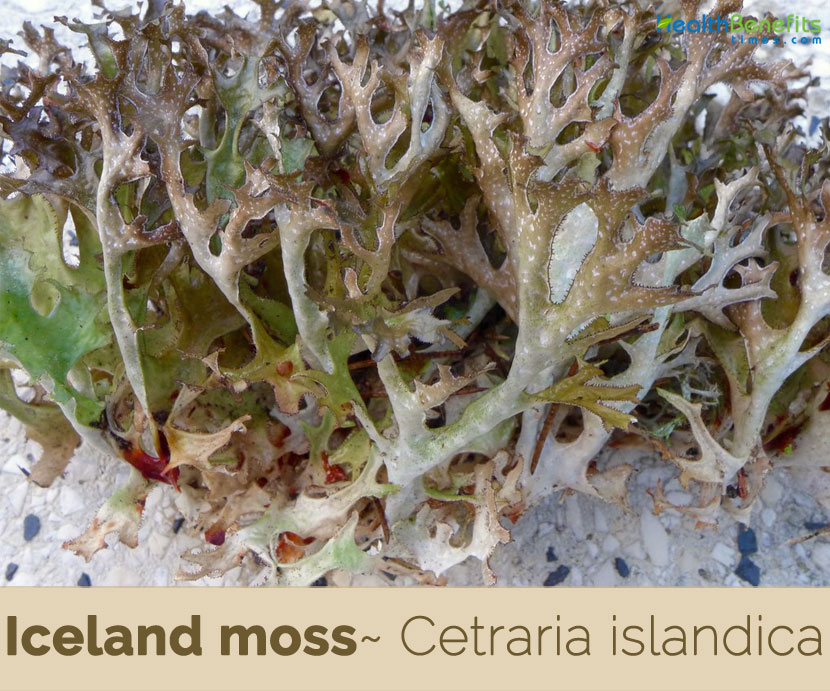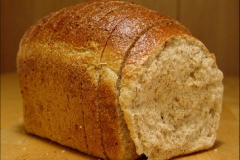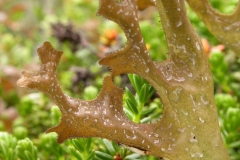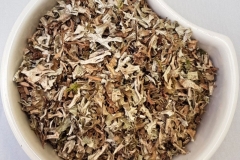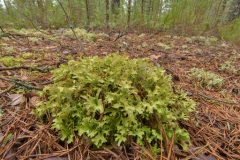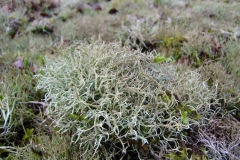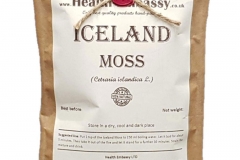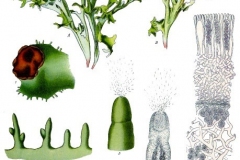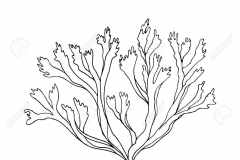| Iceland moss Quick Facts | |
|---|---|
| Name: | Iceland moss |
| Scientific Name: | Cetraria islandica |
| Origin | From Canada to Alaska; south to the Pacific Northwest, Wyoming, Colorado, the Great Lakes states, New England, and in alpine regions in the Appalachians to Tennessee |
| Colors | Upper surface is brown in color lower surface is much lighter shade of brown or is a gray brown with dispersed white spots |
| Shapes | Tough and springy |
| Taste | Bitter |
| Health benefits | Good for chronic pulmonary problems, catarrh, dysentery, chronic digestive disturbances, tuberculosis, cough & bronchitis, dyspepsia, inflammation of mouth and pharynx, loss of appetite |
| Name | Iceland moss |
|---|---|
| Scientific Name | Cetraria islandica |
| Native | From Canada to Alaska; south to the Pacific Northwest, Wyoming, Colorado, the Great Lakes states, New England, and in alpine regions in the Appalachians to Tennessee |
| Common Names | Iceland Lichen, Iceland Moss, True Iceland lichen, island cetraria lichen, Oriental cetraria lichen, eryngo-leaved liverwort |
| Name in Other Languages | Afrikaans: Mosland Albanian: Myshk i iceland Amharic: Ayisilanidi mozayiki (አይስላንድ ሞዛይክ) Arabic: Tahlab ayslanda (طحلب أيسلندا) Armenian: Iceland mamurr (iceland մամուռ) Azerbaijani: Iceland yosunu, İslandiya setrariyası Bengali: Ā isalyānḍa śyā ōlā (আইসল্যান্ড শ্যাওলা) Bulgarian: Islandski much (исландски мъх), islandski lišej (исландски лишей) Burmese: Aite hc laan ray nyhai (အိုက်စလန်ရေညှိ) Catalan: Liquen d’Islàndia Chinese: Bīngdǎo táixiǎn (冰岛苔藓) Croatian: Islandska mahovina, Islandski lišaj Czech: Mech Islandu, pukléřka islandská Danish: Island mos, Fjeldgræss, Hede-græss, Hede-mose, Islandsk mose Dutch: Ijslands mos English: Iceland Lichen, Iceland Moss, True Iceland lichen, island cetraria lichen Esperanto: Islanda musko Estonian: Islandi sammal, Islandi käokõrv Filipino: I Moss lumot Finnish: Islannin sammal, Isohirvenjäkälä French: Mousse d’Islande, Cétraire d’Islande Georgian: Islandiis khavsi (ისლანდიის ხავსი) German: Island Moos, Islandflechte, Isländisch Moos, Isländisch Moos, Isländisches Moos Greek: Vrýa tis Islandías (βρύα της Ισλανδίας) Gujarati: -Ā isalēnḍa mōsa (આઇસલેન્ડ મોસ) Hausa: Dusar kankara Hebrew: איזוב איסלנד Hindi: Aaikalaind mos (आइकलैंड मॉस) Hungarian: Izlandi moha, Izlandi zuzmó Icelandic: Islands mos, Fjallagrös Indonesian: Islandia lumut Irish: Caonach oighir Italian: Muschio d’Islanda Japanese: Aisurandomosu (アイスランドモス), Eirantai (エイランタイ) Javanese: Moss lumut Kannada: Aislyāṇḍ pāci (ಐಸ್ಲ್ಯಾಂಡ್ ಪಾಚಿ) Kazakh: Iceland мүк (Iceland mük), Island mügí (Исланд мүгі) Korean: Aiseullandeu ikki (아이슬란드 이끼) Kurdish: Iceland moss Lao: Moss iceland Latin: Racomitrium moss iceland Latvian: Islandes sūnas, Islandes ķērpis Lithuanian: Islandų samanos, Islandinė kerpena Macedonian: Ysland mov (Исланд мов), islandski lišaj (исландски лишај) Malagasy: Ivana moss Malay: Lumut iceland Malayalam: Aislānṟ mēās (ഐസ്ലാന്റ് മോസ്) Maltese: Hażiż tal-Islanda Marathi: Aaeesaland mos (आईसलँड मॉस) Mongolian: Iceland khövd (iceland хөвд) Nepali: Ā isalyāṇḍa kā ī (आइसल्याण्ड काई) Norwegian: Island moss, Fjeldgræss, Hede-græss, Hede-mose, Islandsk mose, Islandslav Oriya: ଆଇସଲ୍ୟାଣ୍ଡ୍ ମସ୍ | Pashto: د آیسلینډ ماس Persian: ایسلند خزه Polish: Mech islandzki, Płucnica islandzka Portuguese: Musgo da islândia Punjabi: Ā īsalaiṇḍa mausa (ਆਈਸਲੈਂਡ ਮੌਸ) Pushto: آيسلېنډي گل سنگ Romanian: Mușchiul Islandei, Mușchi de piatră Russian: Islandskiy mokh (исландский мох), tsetrariya islandsk (цетрария исландск) Serbian: Islandska mahovina (исландска маховина) Sindhi: آئس لينڊ ماس Sinhala: Ayislanḍ pāsi (අයිස්ලන්ඩ් පාසි) Slovenian: Islandski mah Spanish: Musgo islandia, Islandski lišaj Sundanese: Lukut iceland Swedish: Isländsk mossa, Islandslav Tajik: Mossland (Моссланд) Tamil: Aislāntu pāci (ஐஸ்லாந்து பாசி) Telugu: Aislāṇḍ nācu (ఐస్లాండ్ నాచు) Thai: Mx s̄ xịs̒ lænd̒ (มอสไอซ์แลนด์) Turkish: Lzlanda yosunu Ukranian: Islandsʹkyy mokh (ісландський мох), Islandsʹkyy lyshaynyk (Ісландський лишайник) Urdu: آئس لینڈ کائی Uzbek: Iceland mox Vietnamese: Itub rêu Welsh: Mwsogl Gwlad yr Iâ Zulu: I-iceland moss |
| Plant Growth Habit | Fruticose, or shrub-like bushy lichen |
| Growing Climates | Damp places, usually on rocks and the bark of trees, especially conifers, heaths, dunes, coastal plains, lichen woodlands, bogs, meadows, and tundra, forested sites, nunataks, and rock crevices |
| Soil | Most often found in sandy soil in exposed areas at high elevations. It commonly grows on moist or dry tundra among mosses or in the open |
| Plant Size | 2 to 8 inches (5-20 cm) broad |
| Fruit Shape & Size | Tough and springy |
| Fruit Color | Upper surface is brown in color Lower surface is much lighter shade of brown or is a gray brown with dispersed white spots |
| Propagation | Through vegetative means |
| Available Forms | Infusion, decoction, tincture, extract, oil |
| Plant Parts Used | Whole Lichen |
| Taste | Bitter |
| Season | May and September |
| Health Benefits |
|
Plant Description
Iceland moss is fruticose or shrub-like bushy lichen with a small to medium brown thallus growing loosely on the soil. The thallus (the body of fungi and lichens, being without vascular tissue and not differentiating into root, stem, and leaves) is channeled or rolled into thin, branched tubes, which terminate in flattened lobes fringed with minute papillae, rarely more than 5mm wide. Colonies are 2 to 8 inches (5-20 cm) broad. Apothecia are generally rare. Cetraria islandica displays cushion like growth, making it well suited to weather high winds in harsh environments. It absorbs water slowly and can endure prolonged wet periods.
The whole lichen is very tough and springy. There is a distinct coloration to the body of the Iceland moss; the upper surface is always brown in color. On the other hand, the lower or the outer surface of the moss tends to have a much lighter shade of brown or is a gray brown with dispersed white spots all over it. There are white spots which have a chalky or mealy appearance, and which are lodged in little depressions of the thallus.
Cetraria islandica produces ascospores, but sexual reproduction is infrequent. Reproduction mainly occurs by means of thallus fragmentation or the dispersal of isidia and soredia. Wind or animals may play an important role in the dispersal of these vegetative propagules.
Plant Growth Habit
The plant is found growing in damp places, usually on rocks and the bark of trees, especially conifers, heaths, dunes, coastal plains, lichen woodlands, bogs, meadows, tundra, forested sites, nunataks, and rock crevices. It is most often found in sandy soil in exposed areas at high elevations. It commonly grows on moist or dry tundra among mosses or in the open.
Benefits of Iceland moss
Listed below are few of the health benefits of Iceland moss
1. Coughs/Colds/Bronchitis
The main chemical compounds found in Icelandic Moss are large amounts of a type of starch called lichenin. When this compound is boiled, it turns into a substance resembling mucilage which is particularly soothing to irritated mucous membranes that line the respiratory tract and nasal passages. It also contains complex polysaccharides that have immune-stimulant effects and is especially useful to counter catarrh and calm dry coughs.
It is also powerfully antibiotic, containing usnic acid and other lichen acids that combat bacteria and viruses.
2. Digestive Health
Icelandic Moss is classed as a bitter herb – it stimulates digestive enzymes and enhances the body’s ability to absorb nutrients whilst it is in itself a highly nutritious food.
The aforementioned high mucilage content also exerts its soothing action in the digestive tract and the intestines, which helps to alleviate symptoms of gastritis, gastric ulcers and chronic digestive disturbances. It is also useful in treating digestive disorders caused by parasites due to its ability to gently expel intestinal worms and other parasites.
Traditional uses and benefits of Icelandic Moss
- Iceland moss has been used since ancient times as a cough remedy and has also been used in European folk medicine as a cancer treatment.
- In present day herbalism it is highly prized for its strongly antibiotic and demulcent actions, being used particularly to soothe the mucous membranes of the chest, to counter catarrh and calm dry and paroxysmal coughs – it is particularly helpful as a treatment for elderly people.
- Iceland moss has both a demulcent and a bitter tonic effect within the gut – a combination almost unique amongst medicinal herbs.
- Whole plant is strongly antibiotic, antiemetic, strongly demulcent, galactogogue, nutritive and tonic.
- It is excellent when used internally in the treatment of chronic pulmonary problems, catarrh, dysentery, chronic digestive disturbances (including irritable bowel syndrome and food poisoning) and advanced tuberculosis.
- Externally, it is used in the treatment of boils, vaginal discharges and impetigo.
- The German Commission E Monographs, a therapeutic guide to herbal medicine, approve Cetraria islandica for cough & bronchitis, dyspepsia, inflammation of mouth and pharynx, loss of appetite.
- Historically, C. islandica has been used to treat coughs, tuberculosis, fevers, and scurvy.
- Cetraria islandica has also been used as a source of antibiotics.
- It is traditionally used to relieve chest ailments, irritation of the oral and pharyngeal mucous membranes and to suppress dry cough.
- Some people apply Iceland moss directly to poorly healing wounds.
- Traditionally Iceland moss was considered a galactagogue and to have strong antibiotic, antiemetic, strongly demulcent and nutritive properties.
- Iceland moss has been principally recommended in chronic pulmonary and digestive conditions, particularly phthisis wasting condition also known as pulmonary tuberculosis), dyspepsia, and chronic diarrhea.
- In ancient times, the herb was a traditional herbal cough remedy, and had been used in European folk medicine as a cancer treatment.
- Traditionally it was used to soothe the mucous membranes of the chest, to treat chronic pulmonary problems, to counter catarrh and to calm dry and paroxysmal coughs and as a relief for advanced tuberculosis.
- Mucilage properties of this herb provide a natural treatment for the oral and pharyngeal membranes.
- Its bitter organic tonic action may stimulate the appetite and promote gastric secretion.
- Its soothing action is useful for conditions such as gastritis, gastric ulcer, hiatus hernia, and reflux esophagitis.
- It is thought to be a useful herbal treatment when used internally in the treatment of dysentery, chronic digestive disturbances (including irritable bowel syndrome and food poisoning).
- It was traditionally used for relief of vomiting arising from irritation and inflammation of the stomach.
- It may be a useful herbal remedy for low-grade stomach infections seen when there is low stomach acid production.
- It is used as a remedy for the effects of excess stomach acid secretion and it is thought to be a natural treatment for conditions such as malnourishment, debility, and anorexia.
- Ordinary doses improve the appetite, digestion and general nutrition.
- The herb is used as a surface application to treat boils, vaginal discharges, and impetigo.
- Iceland moss is also used to treat topical problems affecting the skin.
- Iceland moss is excellent for dealing with boils, to quiet down vaginal discharges in women, and to alleviate impetigo affecting the skin.
- Consumption of the Iceland moss aids in the treatment of disorders such as dysentery, chronic pulmonary problems and catarrh, and proves beneficial in dealing all kinds of chronic digestive disturbances – including irritable bowel syndrome and cases of food poisoning.
Culinary Uses
- Jelly is made by boiling the whole plant.
- It is nutritious and medicinal.
- Dried and powdered plant can be mixed with wheat and used in making bread and Cereals.
- Powder made from dried C. islandica can be boiled to yield a jelly used in soups in northern Europe.
- In earlier times, it was much more widely used in breads, porridges, soups etc.
- In foods, Iceland moss is used as an emergency food source in Iceland.
- In manufacturing, Iceland moss is used as a flavoring in alcoholic beverages.
- Traditionally in northern Europe, the powdered lichen was used as a thickener in soups.
- It can also be used to make confectionary, in which case it is made into a jelly and combined with lemon, sugar, chocolate, or almonds.
- In the 19th century it was drunk with cocoa sweetened with sugar for a really wholesome drink in cases of colds and flu.
Other Facts
- Powerful antibiotic can be obtained from the plant and this has become a fundamental ingredient in a wide range of commercially produced disinfectants.
- Brown dye is obtained from the plant.
- Cetraria islandica is valued as “good” forage for horses and pigs, and has been used as fodder for cattle.
- The astringent qualities of C. islandica make it useful in tanning leather.
Precautions
- Rare liver damage.
- Herb bitterness possible in breast milk.
- In excessive doses or with prolonged use, Iceland moss can cause nausea, indigestion, looseness of the bowels, gastric irritation or liver problems.
References:
https://www.itis.gov/servlet/SingleRpt/SingleRpt?search_topic=TSN&search_value=190618#null
https://pfaf.org/user/Plant.aspx?LatinName=Cetraria+islandica
https://www.nps.gov/romo/learn/nature/cetraria_islandica.htm
https://www.botanical.com/botanical/mgmh/m/mosice52.html
https://plants.usda.gov/core/profile?symbol=ceis60
https://www.fs.fed.us/database/feis/lichens/cetisl/all.html
https://en.wikipedia.org/wiki/Cetraria_islandica
https://gd.eppo.int/taxon/CETRIS
https://www.herbal-supplement-resource.com/iceland-moss.html


